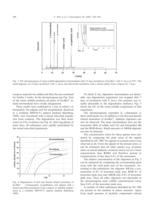
Catalog excerpts

Biodegradation of aliphatic±aromatic copolyesters: evaluation of the ®nal biodegradability and ecotoxicological impact of degradation intermediates U. Witt a, T. Einig b, M. Yamamoto a, I. Kleeberg c, W.-D. Deckwer c, R.-J. Mller c,* u a b BASF AG, Polymer Laboratory, D-67056 Ludwigshafen, Germany BASF AG, Central Analytic ZAX, D-67056 Ludwigshafen, Germany c GBF, Mascheroder Weg 1, D-38124 Braunschweig, Germany Received 30 August 1999; accepted 26 April 2000 Abstract The biological degradation behaviour of the aliphatic±aromatic copolyester Eco¯exâ was investigated with regard to the degree of degradation and the intermediates formed during the degradation process. The individual thermophilic strain Thermomonospora fusca, isolated from compost material, was used for the degradation experiments in a de®ned synthetic medium at 55°C. After 22 days of degradation more than 99.9% of the polymer had depolymerized and with regard to the degradation of the diacid and diol components of Eco¯exâ only the monomers of the copolyesters (1,4butanediol, terephthalate and adipate) could be detected by gas chromatography/mass spectroscopy (GC±MS) measurements in the medium. In interrupted degradation experiments predominantly the monoesters of adipic acid and terephthalic acid with 1,4-butanediol were observed in addition to the monomers. In toxicological tests with Daphnia magna and Photobacterium phosphoreum no signi®cant toxicological eect was observed, neither for the monomeric intermediates nor for the oligomeric intermediates. From a risk assessment it can be concluded that there is no indication for an environmental risk when aliphatic±aromatic copolyesters of the Eco¯ex-type are introduced into composting processes. Ó 2001 Elsevier Science Ltd. All rights reserved. Keywords: Aliphatic±aromatic copolyesters; Actinomycetes; Ecotoxicology; Biodegradation 1. Introduction As a result of increasing problems with domestic waste, particularly with plastics, a new class of polymers especially designed to be biodegradable, has been undergoing development for more than 10 years. Now several of such materials have entered the market and Corresponding author. Tel.: +49-531-6181-610; fax: +49531-6181-175. E-mail address: rmu@gbf.de (R.-J. Mller). u current forecasts deal with a future medium term potential of 200 000±380 000 t/a for western Europe (Verrottungsbeschleuniger fr Polyole®n-Folien, 1994; u BASF Press release, 1998). Generally, biodegradability is exclusively a function of the polymer structure and does not depend on the origin of the raw materials ± whether petrochemically based or from renewable resources (Witt et al., 1999). At present, synthetic biodegradable plastics provide a number of advantages compared to those made from naturally produced macromolecules (e.g. starch, cellulose, poly(hydroxyalkanoates)). Better use properties,
Open the catalog to page 1
processability comparable to conventional plastics, constant material quality and in many cases a signi®cantly lower price point in favour of synthetic materials, at least as components in biodegradable plastic compositions. Beside the natural polyesters (e.g. PHB), many other synthetic aliphatic polyesters are susceptible to microbial attack. Recently, it was shown that synthetic copolyesters containing aromatic constituents are also degraded by microorganisms. The degradation decreases as the amount of aromatic components increases (Witt et al., 1995, 1997). In 1998, an aliphatic±aromatic...
Open the catalog to page 2
2.3.1. OH±OH-terminated oligomer mixture The aromatic oligomer mixture with OH-terminal group was synthesized by bulk condensation. DMT (5 mol/971 g), 1,4-butanediol (10 mol/901 g) and tetrabutyl orthotitanate (1.8 g) were heated in a 2 l round bottom ¯ask equipped with a metal stirrer and a cooler at 160±190°C for 17 h. The reaction mixture was cooled, and the product was washed thoroughly with acetone and dried at 70°C under reduced pressure for 16 h. 2.3.2. COOH±COOH-terminated oligomer mixture Terephthalic acid dichloride (160 mmol/32.48 g) was dissolved in 100 ml of N-methylpyrrolidone...
Open the catalog to page 3
2.8.2. Determination of adipic acid, terephthalic acid and esters thereof with 1,4-butanediol 25 g of the aqueous samples were lyophilized for 4 days. The residue was extracted with 5 ml of dioxane and derivatized with 2 ml of MSTFA for 4 h at 80°C. The degree of recovery was checked by spiking the sample with appropriate amounts of adipic acid and terephthalic acid and terephthalic diester with 1,4-butanediol in dioxane. The contents of the esters of adipic acid and 1,4-butanediol identi®ed by GC±MS (see below) were estimated based on the comparison of the corresponding peak areas. The...
Open the catalog to page 4
3. Results 3.1. Analysis of degradation products and intermediates A degradation test with the actinomycete strain T. fusca DSM 43793 in the synthetic medium was run for 21 days using Eco¯exâ powder. In the control experiment, a Eco¯exâ ®lm (50 lm thickness) was visually decomposed after approximately 4 days under comparable test conditions. Thus, an almost complete depolymerization of the polyester powder could be expected. In the degradation experiment initially 2133 mg Eco¯exâ was added to the medium. At the end of the test (21 days) 127 mg of solid substance, consisting of potential...
Open the catalog to page 5
Fig. 3. GC-chromatogram of water-soluble degradation intermediates after 21 days incubation of Eco¯exâ with T. fusca at 55°C. The small diagram: (a) 14 days incubation with T. fusca and afterwards incubation with a mixed culture from compost for 7 days. compost material was added and then the test continued for further 2 weeks. In the chromatogram (see Fig. 3(a)) of the water soluble products all peaks of Eco¯exâ related intermediates have totally disappeared. These results were con®rmed by a test, in which 1,4butanediol, Na adipate and Na terephthalate, dissolved in a synthetic MSV/0.5%...
Open the catalog to page 6All BASF Energy efficiency catalogs and technical brochures
-
Basotect®
30 Pages
-
STYRODUR ®
10 Pages
-
ecovio FS Paper C 1500
7 Pages





